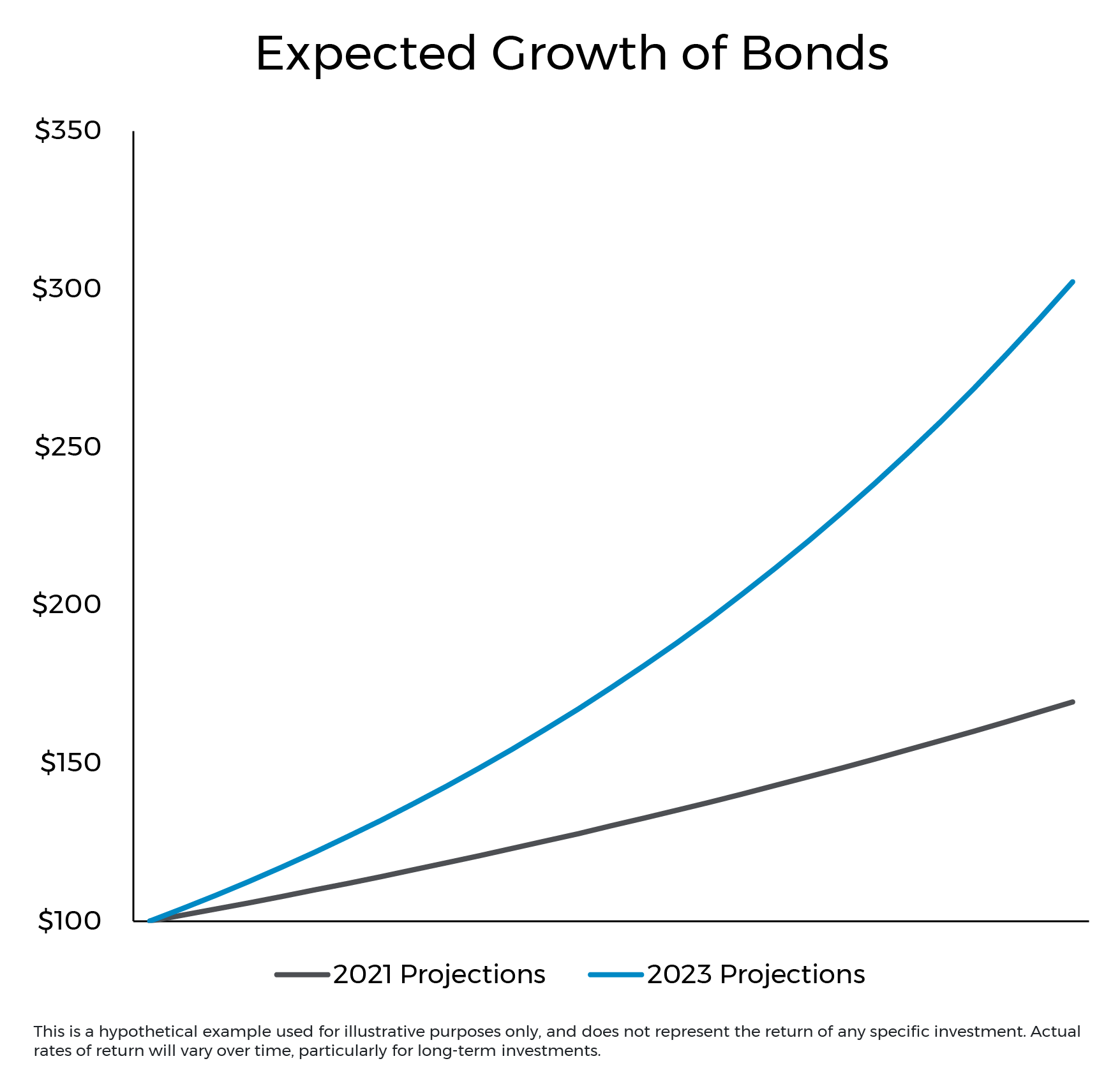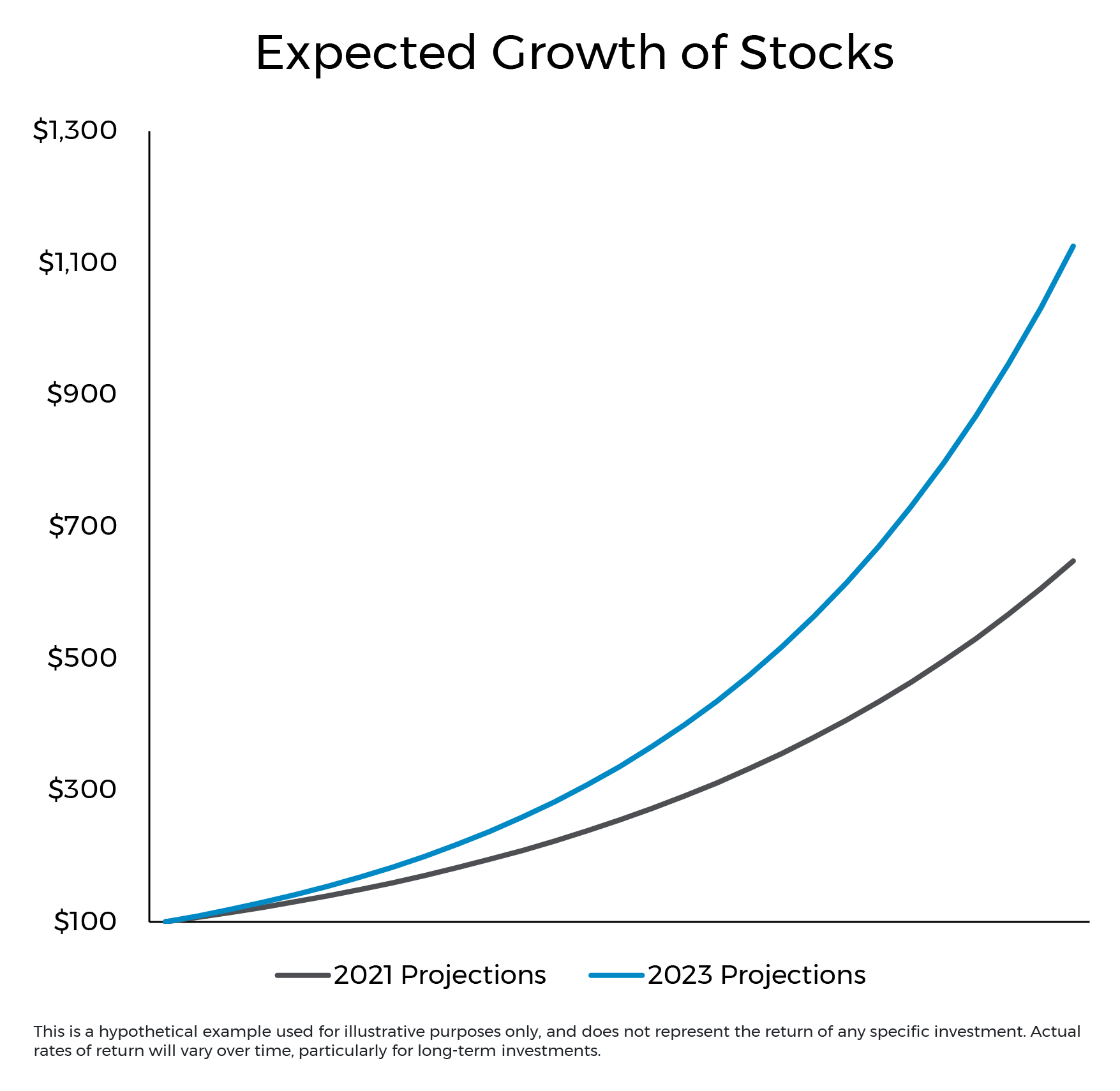The markets of 2022 and 2023 have been a roller coaster to say the least.
In 2022, rising interest rates and the twin fears of inflation and recession roiled markets, with both stocks and bonds dropping sharply.
Then 2023 delivered the recovery we were hoping for, but it did not always feel that way. Markets spent most of the year seesawing and treading water. It was not until the end of October when stocks and bonds went vertical, finally erasing almost all the downturn of 2022.
You might reflect on the last two years and think, after all that volatility and stress, that you are pretty much back to where you were at the end of 2021. Looking only at portfolio values and cumulative returns, that is generally true. Underneath the surface, however, this is far from the truth.
For a retiree, the most critical and basic function of a financial plan is to provide confidence that one will not run out of money. From that perspective, today’s market inspires much more confidence than at the end of 2021! For our clients, sustainable spending projections over a retiree’s lifetime have increased significantly over the last two years, improving financial plans and providing greater confidence in the ability to achieve one’s goals.
We are not the only ones pointing out this incredible increase in financial security for retirees. Looking at recent articles from Morningstar (The Good News on Safe Withdrawal Rates) and the Wall Street Journal (The 4% Rule for Retirement Is Back), we find similar commentary. These articles point to the same factors that give us optimism — increased spending outlooks for retirees and higher long-term net worth projections for younger investors.
Why has this happened?
The simple answer is that interest rates have increased significantly since early 2022, thereby increasing future expected returns in stocks and bonds.
It is easy to see this on the bond side. Long-term government bonds yielded 1.90% at the end of 2021 and currently yield 4.03% — a dramatic increase in yield over a short period of time, especially after the extended low-yield environment we have experienced since the financial crisis of 2008-09.1
The good news is this yield increase is not driven by higher inflation expectations. For those keeping score at home, from the end of 2021 to today, long-term annual inflation expectations actually dropped slightly from 2.34% to 2.13%.2 Rather, the increase in bond yields is driven by the increase in after-inflation or “real” expectations. Said another way, it is an increase in expected purchasing power for investors long term.
Using a retired couple at age 65 as an example, the Internal Revenue Service predicts they would have a joint investing lifetime of about 28 years. Compounding the former low yield of 1.90% per year for 28 years would yield a cumulative return of 69%. By contrast, compounding today’s 4.03% yield for 28 years returns 202%, an astoundingly higher number.

Turning to stocks, we see a similar dynamic. The expected annual return on stocks was 6.90% per year at the end of 2021. Over 28 years, that would compound 548% cumulatively, or in dollar terms, $100 invested would grow to $648. Today, the expected annual return on stocks (thanks to something called the equity risk premium) would be 9.03% per year.3 At that rate, an investment would compound 1,025% over the same 28-year period! The same $100 would grow to $1,125, increasing projected wealth by almost 75% relative to 2021 projections.

Thus, as interest rates have increased, expected returns across the board have likewise increased significantly.
The net effect of this dramatic increase in yields is that long-term financial projections have dramatically improved for investors over the past two years.
How do we look at this from a historical perspective?
For 65-year-olds, this is arguably the best financial planning environment since their 40s. For younger investors, especially those below the age of 45, this is arguably the best environment in their investment lifetimes to date.
As we stated above, looking only at portfolio values might leave you with the impression that the last two years were a lot of ups and downs with no real forward progress. However, those ups and downs were the market’s way of adjusting to the fundamentally different environment of higher interest rates, and that has serious (and positive!) implications for investors going forward. By acknowledging that and focusing on the more important long-term perspective, there are great reasons for optimism.
Our takeaway for you? Take that long-term view, as always. Recognize that the last two years have been a surprising gift for long-term investors, delivering a very bright outlook going forward. It’s a Happy New Year indeed!
SOURCES
1 “Interest Rate Statistics.” U.S. Department of the Treasury, Accessed January 8, 2024.
2 Ibid.
3 The equity risk premium is a stock investor’s expected additional return over and above “risk-free” 10-year U.S. Treasury bonds, and it is viewed as compensation for taking the risk of owning stocks relative to risk-free Treasuries. As bond yields increase, so does the expected return on stocks. In this case, the expected return on stocks increased about 2%, which is a direct correlation to the increase in interest rates.
This information is for educational purposes and is not intended to provide, and should not be relied upon for, accounting, legal, tax, insurance, or investment advice. This does not constitute an offer to provide any services, nor a solicitation to purchase securities. The contents are not intended to be advice tailored to any particular person or situation. We believe the information provided is accurate and reliable, but do not warrant it as to completeness or accuracy. This information may include opinions or forecasts, including investment strategies and economic and market conditions; however, there is no guarantee that such opinions or forecasts will prove to be correct, and they also may change without notice. We encourage you to speak with a qualified professional regarding your scenario and the then-current applicable laws and rules.
Asset allocation and diversification do not assure or guarantee better performance and cannot eliminate the risk of investment losses. There is no guarantee a diversified portfolio will enhance overall returns or outperform a non-diversified portfolio, nor does diversification protect against market risk. All investment strategies have the potential for profit or loss, including loss of principal. The future performance of any investment or financial planning strategy, including those recommended by Forum, may not be profitable or suitable or prove successful. Individual client results may vary. Past performance is not indicative of future results.
By clicking on a third-party link, you will leave the Forum website. Forum is linking to this third-party site to share information in a different format and is for informational purposes only. However, Forum cannot attest to the accuracy of information provided by this site or any other linked site. Forum does not endorse the site sponsors or the information or products presented there. Privacy and security policies may differ from those practiced by Forum.





